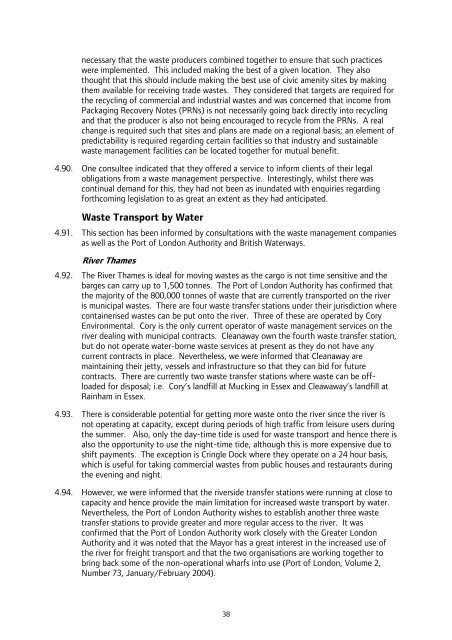London Wider Waste Strategy - London - Greater London Authority
London Wider Waste Strategy - London - Greater London Authority
London Wider Waste Strategy - London - Greater London Authority
You also want an ePaper? Increase the reach of your titles
YUMPU automatically turns print PDFs into web optimized ePapers that Google loves.
necessary that the waste producers combined together to ensure that such practices<br />
were implemented. This included making the best of a given location. They also<br />
thought that this should include making the best use of civic amenity sites by making<br />
them available for receiving trade wastes. They considered that targets are required for<br />
the recycling of commercial and industrial wastes and was concerned that income from<br />
Packaging Recovery Notes (PRNs) is not necessarily going back directly into recycling<br />
and that the producer is also not being encouraged to recycle from the PRNs. A real<br />
change is required such that sites and plans are made on a regional basis; an element of<br />
predictability is required regarding certain facilities so that industry and sustainable<br />
waste management facilities can be located together for mutual benefit.<br />
4.90. One consultee indicated that they offered a service to inform clients of their legal<br />
obligations from a waste management perspective. Interestingly, whilst there was<br />
continual demand for this, they had not been as inundated with enquiries regarding<br />
forthcoming legislation to as great an extent as they had anticipated.<br />
<strong>Waste</strong> Transport by Water<br />
4.91. This section has been informed by consultations with the waste management companies<br />
as well as the Port of <strong>London</strong> <strong>Authority</strong> and British Waterways.<br />
River Thames<br />
4.92. The River Thames is ideal for moving wastes as the cargo is not time sensitive and the<br />
barges can carry up to 1,500 tonnes. The Port of <strong>London</strong> <strong>Authority</strong> has confirmed that<br />
the majority of the 800,000 tonnes of waste that are currently transported on the river<br />
is municipal wastes. There are four waste transfer stations under their jurisdiction where<br />
containerised wastes can be put onto the river. Three of these are operated by Cory<br />
Environmental. Cory is the only current operator of waste management services on the<br />
river dealing with municipal contracts. Cleanaway own the fourth waste transfer station,<br />
but do not operate water-borne waste services at present as they do not have any<br />
current contracts in place. Nevertheless, we were informed that Cleanaway are<br />
maintaining their jetty, vessels and infrastructure so that they can bid for future<br />
contracts. There are currently two waste transfer stations where waste can be offloaded<br />
for disposal; i.e. Cory’s landfill at Mucking in Essex and Cleawaway’s landfill at<br />
Rainham in Essex.<br />
4.93. There is considerable potential for getting more waste onto the river since the river is<br />
not operating at capacity, except during periods of high traffic from leisure users during<br />
the summer. Also, only the day-time tide is used for waste transport and hence there is<br />
also the opportunity to use the night-time tide, although this is more expensive due to<br />
shift payments. The exception is Cringle Dock where they operate on a 24 hour basis,<br />
which is useful for taking commercial wastes from public houses and restaurants during<br />
the evening and night.<br />
4.94. However, we were informed that the riverside transfer stations were running at close to<br />
capacity and hence provide the main limitation for increased waste transport by water.<br />
Nevertheless, the Port of <strong>London</strong> <strong>Authority</strong> wishes to establish another three waste<br />
transfer stations to provide greater and more regular access to the river. It was<br />
confirmed that the Port of <strong>London</strong> <strong>Authority</strong> work closely with the <strong>Greater</strong> <strong>London</strong><br />
<strong>Authority</strong> and it was noted that the Mayor has a great interest in the increased use of<br />
the river for freight transport and that the two organisations are working together to<br />
bring back some of the non-operational wharfs into use (Port of <strong>London</strong>, Volume 2,<br />
Number 73, January/February 2004).<br />
38
















